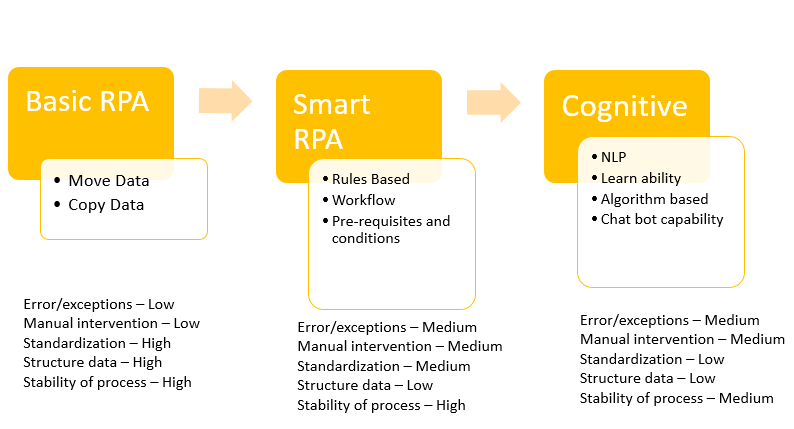This involves data analysis based on all previous data to provide a summary as well as projections based on 12-week data.
RPA is in that part of its lifecycle where the question most asked is, how best to adapt and not should we adopt?
Organisations looking at increasing their bottom-line profitability have been looking at ways to make their processes lean and more efficient at a lower cost. Automation in the recent past has proved to be a simple yet effective solution to meet this objective.
During the last 10 -15 years, organisations have focussed on standardising the backend processes of their finance, supply chain and HR functions. These processes today are so standardised and rule-driven that they can actually be run with a software robot.
Even so, there are a good number of processes that are complex enough and with lower standardisation that require a certain amount of learning.
What are the general characteristics of processes that lend themselves to Automation and how does it determine the complexity of the RPA solution itself?

The question, therefore, is how geared are the RPA platform vendors to meet these requirements?
Everest Group has placed Automation Anywhere, Blueprism and UiPath as amongst the leaders among current RPA software vendors. While it may be considered true to an extent, both because of their client traction and each of them having a set of features that can automate highly standardised processes, they are found wanting the moment the process has variations. Many of the standardised processes themselves may not be 100% automated because of slight variations. This where the vendors need to step up and make their platforms highly dependable despite minor variations.
In a given environment there are bound to be variations in processes. The more the variations, the less stable the RPA solution will be in the current context. The vendors will find that while the standard processes can be addressed fairly easily by their platforms, the differentiation will arise amongst them with the ability to be able to address the vagaries of the business process that occurs in runtime. This is where the capabilities around learnability, rules and algorithms, decision tree’s etc. will play a significant part.
This gap is currently addressed through a layer of governance covering IT, Business and RPA. All the changes that occur in a given landscape, be they from a process standpoint or technically, are flagged to the RPA team fairly early in the change lifecycle. The RPA team is then responsible to make sure the BOT is trained sufficiently to adjust to the new changes.
We believe that an alternate approach is to build components and capabilities that can help address these situations. These include a configurable rules framework that can be used to accommodate process variations that can be used under various scenarios across business functions.
In conclusion, RPA platforms and solutions are at a nascent stage where it demands very highly structured and defined processes. The role of RPA experts who have a good process and technology background is essential to provide a robust and comprehensive solution to businesses.
Download

